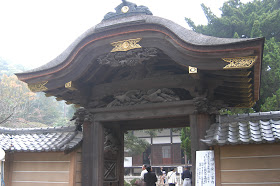Previous posts in this series:
- Heijūmon
- Kabukimon
- Kōraimon
- Yakuimon
- Yotsu-ashimon
- Munamon
- Commentary
- Uzumimon
- Yaguramon
- Rōmon
- Shōrōmon
- Taikomon
- Nijūmon
- Sanmon
- Niōmon
- Nitenmon
- Sōmon
- Wakimon
Chokushimon (勅使門)
Literally, the imperial edict (勅) messenger (使) gate (門). The two-character compound choku-shi (勅使) means 'imperial messenger', and these gates, most of which can be found in Kyoto Prefecture, were intended to be used only by imperial messengers. Since imperial messengers are a bit thin on the ground these days, the vast majority of these gates are not used any more- they have low fences placed in front to bar entry, and the doors are kept closed. I wonder if anyone ever uses them for any reason, or are they simply maintained as historical aritfacts?
Most chokushimon are of the yotsuashimon (four-legged) type, with a variety of roof styles. Since such gates were for the entry of imperial persons, these gates are often ornately decorated and many feature beautiful kara-hafu (cusped gable) roofs.
Let's start with this beauty, at Kenchōji (建長寺) in Kamakura:
Also in Kamakura - Engakuji (円覚寺) has a chokushimon:
A rare example with an open gate of this type, permitting ordinary souls to pass through.
Next, Nanzenji's messenger gate (南禅寺), in Kyoto:
Ken-nin-ji (建仁寺) also has one:
Chokushimon generally associate to Buddhist temples, however they are also found at Shrines, such as this one at Awaga-jinja () in Hyogo Prefecture:
Sigh! A most tranquil scene, the sort of thing that only the Japanese can put together.
Some imperial messenger gates have imperial crests, mon, place prominently on the doors, as in this example from Daigoji (醍醐寺) in Kyoto:
Another in the same vein, Yufukuji (祐福寺) in Aichi Prefecture:
One more, this time with carved crests of the imperial chrysanthemum, Shōfukuji (聖福寺) in Fukuoka:
Here's one at the famous Daitokuji (大徳寺) in Kyoto:
Had enough yet? Not me! I could look at these all day, one after another.
Jōshōkō-ji (常照皇寺), also in Kyoto:
Kenkōan (源光庵) in Kyoto:
And one more for good luck, Zenrinji (禅林寺) in Kyoto:
These are some of my favorite gates in all of Japan. But then, I'm a sucker for the cusped gable roof form.
You'll find that clicking on any of the images will produce larger pictures, so please don't forget to click. Thanks for coming by the Carpentry Way. This gate series will continue - - on to post 20










.jpg)

Chris
ReplyDeleteThanks for mentioning the enlargement option. It really opens up the incredible detail lavished on these gates. Long live the 'kara-hafu'!
Tom
Tom,
ReplyDeletemy sentiments exactly!
~C